Normally open and normally closed switch contacts are the terminology used to describe the open and close positions of the switch in normal conditions. Here, a normal condition is a condition when the switch is not energized manually or electrically. Normally open condition means the contact of the switch is in an open position when it is not energized. In a similar way, the normally close condition means the switch is in the close position when there is no force on its actuator.
The terms NO and NC are confusing if not comprehended conceptually, In this article, we will have a detailed discussion on these terms and their examples.
What is a Switch?
A switch is a simple element to turn on or off any device or equipment. Thus, a switch can be defined as an electrical component that connects and disconnects the electrical path. A switch is a binary device ( that has two states -0 or 1); they are either completely closed (On) or completely open(off).
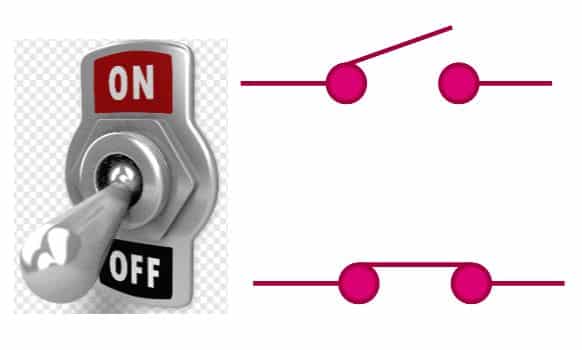
The switch has electrical contacts that can make and break the path of an electrical circuit. Electrical contacts are of two types- Open contact and Close contact. Every switch has a position of contacts termed as normally open or normally closed contact. A switch may have more than one set of normally open and/or normally close contacts, 1 NO+1NC, 2NO+2NC,3NO+3NC, or even more.
What is Normally Open Contact?
When a switch is in a normal position, the contacts of the switch remain either in the open or closed state as per its design. The contact of the switch that remains in an open position when it is not energized by manual or electrical force is called Normally open contact. The normally open contact is abbreviated as NO. The normally open (NO) contact of the switch is shown in the below figure.
The current does not flow in the circuit as long as the switch remains in its normally open state.
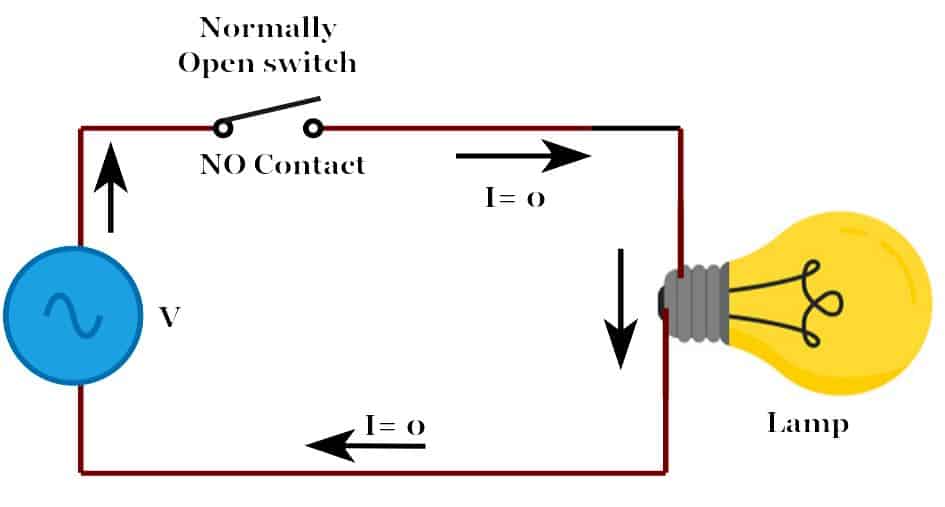
On energization of the switch, the normally open contact of the switch changeovers to a close position, and the current starts flowing in the circuit. and the lamp glows as shown in the below figure.
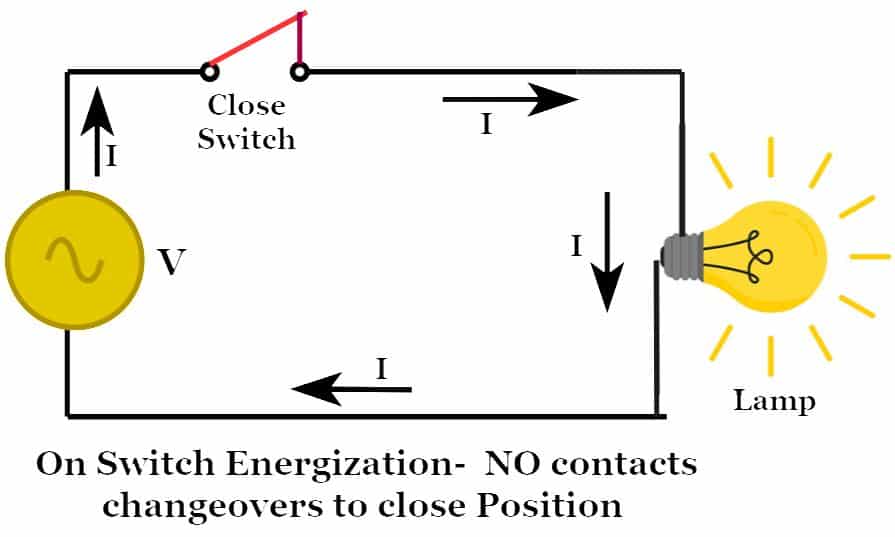
Normally open contact can change its state to a close position if the switch actuates by any type of energy, such as mechanical, pneumatic, hydraulic, or electrical. Thus, the actuation of the switch causes contact changeovers from the normally open to the closed position.
As the status of the switch’s contact is open without applying any force or any energy or any kind of involvement with the switch, the switch’s contact is termed as Normally Open Contact.
What is Normally Closed Contact?
When the contact of a switch remains closed without the application of any force or any energy or any kind of involvement with the switch, the contact is termed as a normally closed contact.
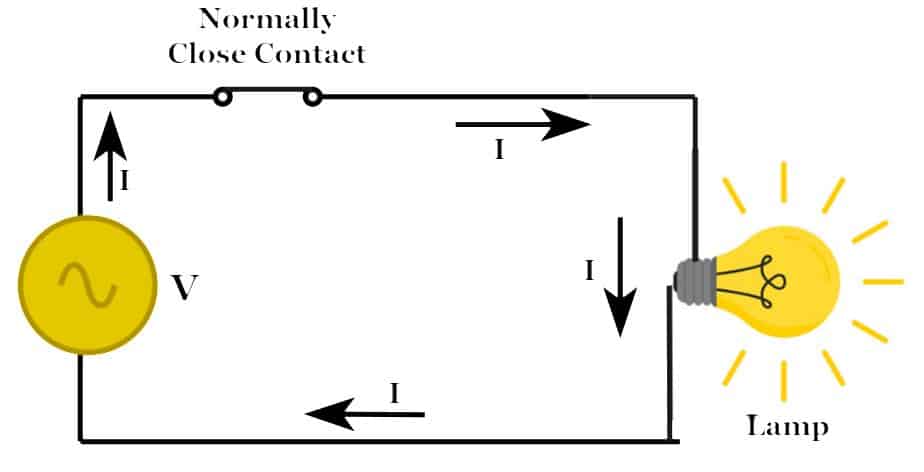
The normally closed contact can be made open only with the application of some sort of energy, either mechanical or electrical. Thus, the applied energy creates the force that actuates the switch, and thus normally closed contact changes its state to an open position.
As the status of the switch’s contact is close without applying any force or any energy or any kind of involvement with the switch, the switch’s contact is termed as Normally Closed Contact.
Example of Normally Open Contact
The below figure shows a motor that is connected to the power supply with a switch in series. Now in order to operate the motor, the switch needs to be pressed or actuated by any means. By pressing or actuating the switch, the motor gets the power supply and it starts operating. In this case, the switch is having open contact and in order to make the contact close, the switch needs to be pressed or actuated by any means.
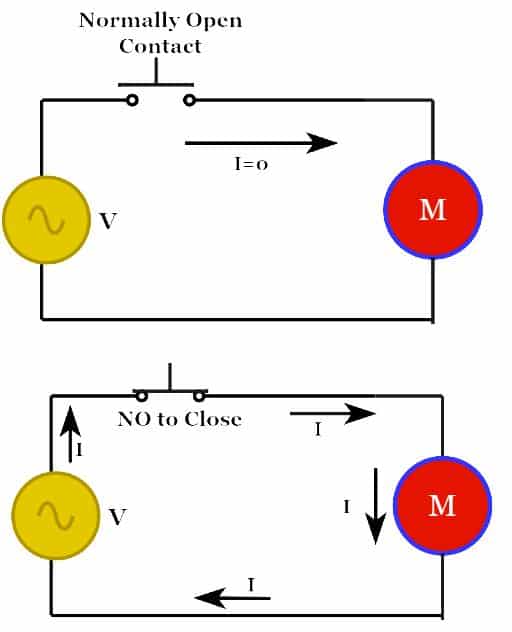
To stop the motor, the switch again needs to come to its original position so that the contact becomes open again.
As the status of the switch’s contact is open without pressing or applying any force, the contact of the switch is termed as Normally Open Contact.
Example of Normally Closed Contact
The below figure has a contact that is connected in the same way as we have seen in the first case. The only difference is that here, the contact is normally closed contact. Here, in normal conditions i.e. without pressing the switch or without actuating the switch, the motor will keep running. So, in this case, whenever the switch will be pressed or actuated by any means, the contact will become open. Hence, due to the loss of power to the motor, the motor will stop.
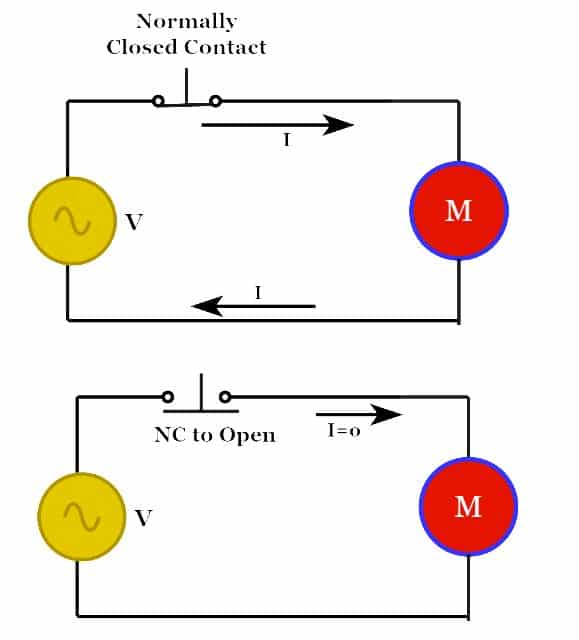
From the above, it is clear that we can control the motor with both NO and NC switch configurations. Both NO and NC of the switch do the same function of make and break. Both are able to operate the motor. Then why do we need Normally Open and Normally Closed contacts? The answer is that the switch configuration NO or NC is selected in order to have the operation of the motor as per the control philosophy.
The different types of switches in NO and NC configurations are used in the process control. Now we will discuss various types of switches and their functionality. It will further clarify the concept of NO and NC switch terminology.
Types of switches:
The below table shows the types of switches and their application.
| Types of switch | Function |
| Temperature Switch | Detects high temperature |
| Level Switch | Detects high as well as low level |
| Flow Switch | Detects Low flow |
| Vibration Switch | Detects high vibration |
| Limit Switch | Detects Position |
| Proximity Switch | Detects zero speed |
| Pressure switch | detects high pressure or vacuum |
Above switches are widely used in the instrumentation field for controlling various processes. The symbols of the various switches are given below.
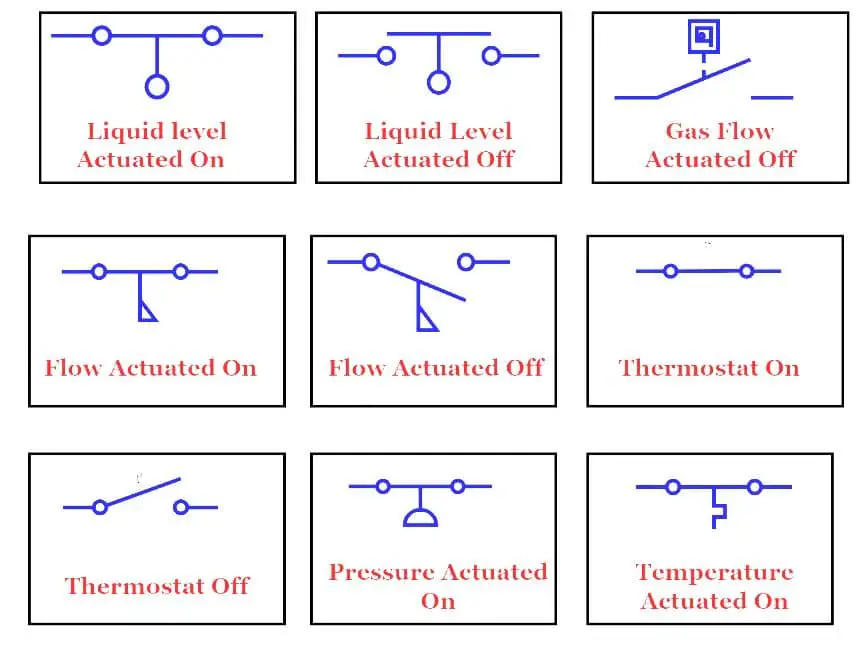
The switches are also used in Emergency Shutdown Systems to prevent major damage.
Now consider a case in which a tank is present. The tank has a running reaction. There is an interlock given to trip the process when the tank’s pressure reaches high pressure. Else the tank will blast. Here we will take an example of both types of contacts used for pressure switches i.e. normally open contact and normally closed contact.
Configuration-1
The pressure switch’s contact will be open when the pressure is normal. When the pressure will go above the set pressure, the switch’s contact will change to close contact. In this case, the system will receive the voltage back when the pressure becomes high and actuate the switch to make close contact.
Configuration-2
The pressure switch’s contact remains closed when the pressure is normal. When the pressure goes above the set pressure, the switch’s contact will change to open contact. The system will continuously receive the voltage unless the pressure becomes high and the contact becomes open.
Now think that the cable connecting the switch and the system breaks because of some reason. For Configuration 1, the system will never get the voltage back because the cable is broken. Now the tank’s pressure becomes high and the switch’s contact becomes closed, but the system will not receive back the voltage because of the cable cut. So definitely tank will blast.
Configuration 2 will be useful in this situation. Here if the cable breaks, the system will trip the process because the system stops getting the voltage back.
Configuration 2 is one of the most famous and it is important concepts called Fail Safe.
For electrical motors also, the stop command is used such that the contact remains closed when the motor is running. Whenever this contact becomes open, the motor stops.